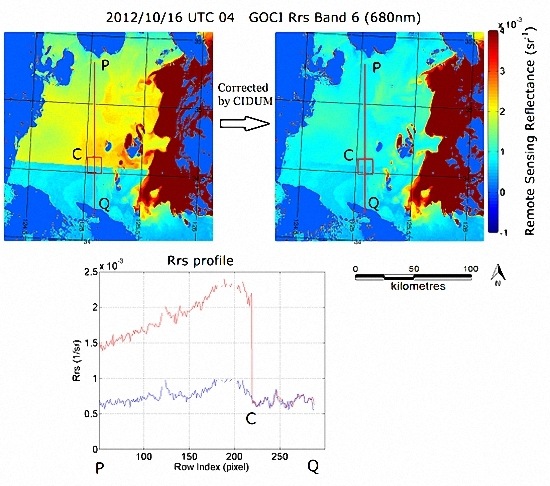Evaluation of Stray Light Correction for GOCI Remote Sensing Reflectance Using in Situ Measurements
Abstract
:1. Introduction
2. Materials and Methods
2.1. CIDUM Algorithm with Minor Modification
2.2. Study Area and Field Measurements
2.3. Aerosol Estimation Process for Turbid Waters
- (Step 1) Estimating aerosol reflectance in the NIR bands (745 and 865 nm)
- (Step 2) Selecting the aerosol models and estimating aerosol reflectance
- (Step 3) Updating for the visible bands
- (Step 4) Estimating water reflectance at the NIR bands
- (Step 5) Repeating Steps 1 through 4 until convergence
3. Results
3.1. Boundary Analysis
3.2. Assessment with in Situ Radiometric Measurements
4. Discussion
5. Conclusions
Acknowledgments
Author Contributions
Conflicts of Interest
Abbreviations
| ISRD: | Interslot radiometric discrepancy |
| SLRI: | Stray-light-driven radiometric inflation |
| CIDUM: | Correction of the interslot discrepancy using the minimum noise fraction transform |
| GOCI: | Geostationary ocean color imager |
| MNF: | Minimum noise fraction |
| TOA: | Top of atmosphere |
| L1A: | Level 1A |
| L1B: | Level 1B |
| APD: | Absolute mean percentage difference |
| RPD: | Relative mean percentage difference |
| SPM: | Suspended particulate matter |
Appendix: The Minimum Noise Fraction (MNF) Transform
References
- Ryu, J.-H.; Han, H.-J.; Cho, S.; Park, Y.-J.; Ahn, Y.-H. Overview of Geostationary Ocean Color Imager (GOCI) and GOCI Data Processing System (GDPS). Ocean Sci. J. 2012, 47, 223–233. [Google Scholar]
- Choi, J.-K.; Park, Y.-J.; Ahn, J.-H.; Lim, H.-S.; Eom, J.; Ryu, J.-H. GOCI, the world’s first geostationary ocean color observation satellite, for the monitoring of temporal variability in coastal water turbidity. J. Geophys. Res. 2012, 117. [Google Scholar] [CrossRef]
- Kang, G.; Coste, P.; Youn, H.; Faure, F.; Choi, S. An in-orbit radiometric calibration method of the geostationary ocean color imager. IEEE Trans. Geosci. Remote Sens. 2010, 48, 4322–4328. [Google Scholar] [CrossRef]
- Kim, W.; Ahn, J.-H.; Park, Y.-J. Correction of stray-light-driven interslot radiometric discrepancy (ISRD) present in radiometric products of Geostationary Ocean Color Imager (GOCI). IEEE Trans. Geosci. Remote Sens. 2015, 53, 5458–5472. [Google Scholar]
- Oh, E.; Hong, J.; Kim, S.-W. Novel ray tracing method for stray light suppression from ocean remote sensing measurements. Opt. Express 2016, in press. [Google Scholar]
- Green, A.A.; Berman, M.; Switzer, P.; Craig, M. A transformation for ordering multispectral data in terms of image quality with implications for noise removal. IEEE Trans. Geosci. Remote Sens. 1988, 26, 65–74. [Google Scholar] [CrossRef]
- Goodenough, D.G.; Dyk, A.; Niemann, O.; Pearlman, J.S.; Chen, H.; Han, T.; Murdoch, M.; West, C. Processing Hyperion and ALI for forest classification. IEEE Trans. Geosci. Remote Sens. 2003, 41, 1321–1331. [Google Scholar] [CrossRef]
- Vermote, E.F.; Tanre, D.; Deuze, J.L.; Herman, M.; Morcrette, J.J. Second simulation of the satellite signal in the solar spectrum, 6S: An overview. IEEE Trans. Geosci. Remote Sens. 1997, 35, 675–686. [Google Scholar] [CrossRef]
- Moon, J.-E.; Park, Y.-J.; Ryu, J.-H.; Choi, J.-K.; Ahn, J.-H.; Min, J.-E.; Ahn, Y.-H. Initial validation of GOCI water products against in situ data collected around Korean peninsula for 2010–2011. Ocean Sci. J. 2012, 47, 261–277. [Google Scholar] [CrossRef]
- Ahn, J.-H.; Park, Y.-J.; Kim, W.; Lee, B.; Oh, L.-S. Vicarious calibration of the Geostationary Ocean Color Imager. Opt. Express 2015, 23, 23236–23258. [Google Scholar] [CrossRef] [PubMed]
- Gordon, H.; Wang, M. Retrieval of water-leaving radiance and aerosol optical thickness over the oceans with SeaWiFS: A preliminary algorithm. Appl. Opt. 1994, 33, 443–452. [Google Scholar] [CrossRef] [PubMed]
- Ruddick, K.; Cauwer, V.D.; Park, Y.-H.; Moore, G. Seaborne measurements of near infrared water-leaving reflectance: The similarity spectrum for turbid waters. Limnol. Oceanogr. 2006, 51, 1167–1179. [Google Scholar] [CrossRef]
- GOCI Sensor Calibration Team; (Korea Ocean Satellite Center, Korea Institute of Ocean Science and Technology, Ansan-si, Gyeonggi-do, Republic of Korea). Personal Communication, 2015.
- Bailey, S.W.; Franz, B.A.; Werdell, P.J. Estimation of near-infrared water-leaving reflectance for satellite ocean color data processing. Opt. Express 2010, 18, 7521–7527. [Google Scholar] [CrossRef] [PubMed]
- Shi, W.; Jiang, L.; Wang, M. Atmospheric correction using near-infrared bands for satellite ocean color data processing in the turbid western Pacific region. Opt. Express 2012, 20. [Google Scholar] [CrossRef]
- Singh, R.K.; Shanmugam, P. Corrigendum to “A novel method for estimation of aerosol radiance and its extrapolation in the atmospheric correction of satellite data over optically complex oceanic waters” [Remote Sensing of Environment 142 (2014) 188–206]. Remote Sens. Environ. 2014, 148, 222–223. [Google Scholar] [CrossRef]
- Saulquin, B.; Fablet, R.; Bourg, L.; Mercier, G.; d’Andon, O.F. MEETC2: Ocean color atmospheric corrections in coastal complex waters using a Bayesian latent class model and potential for the incoming sentinel 3—OLCI mission. Remote Sens. Environ. 2016, 172, 39–49. [Google Scholar] [CrossRef]
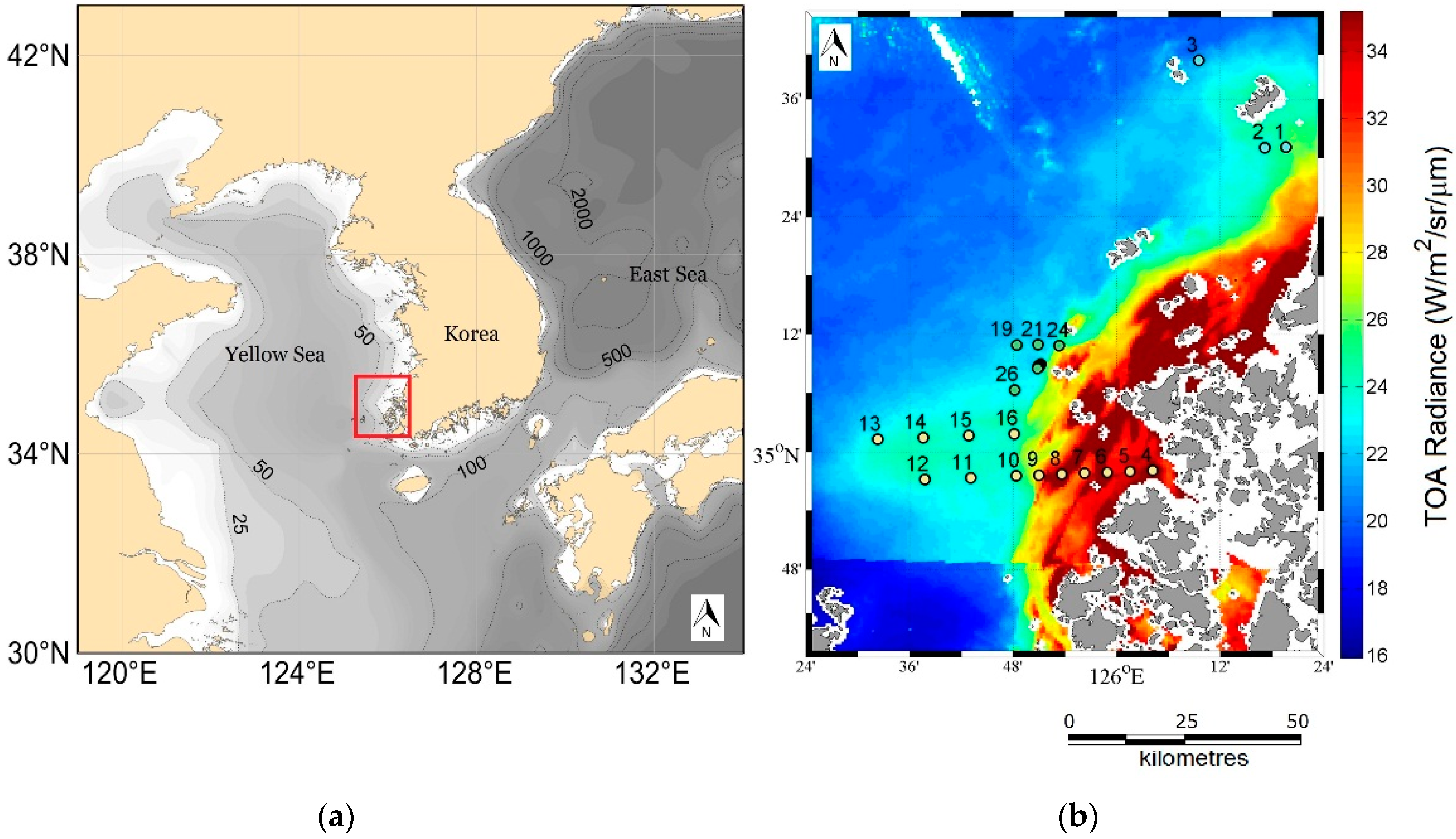
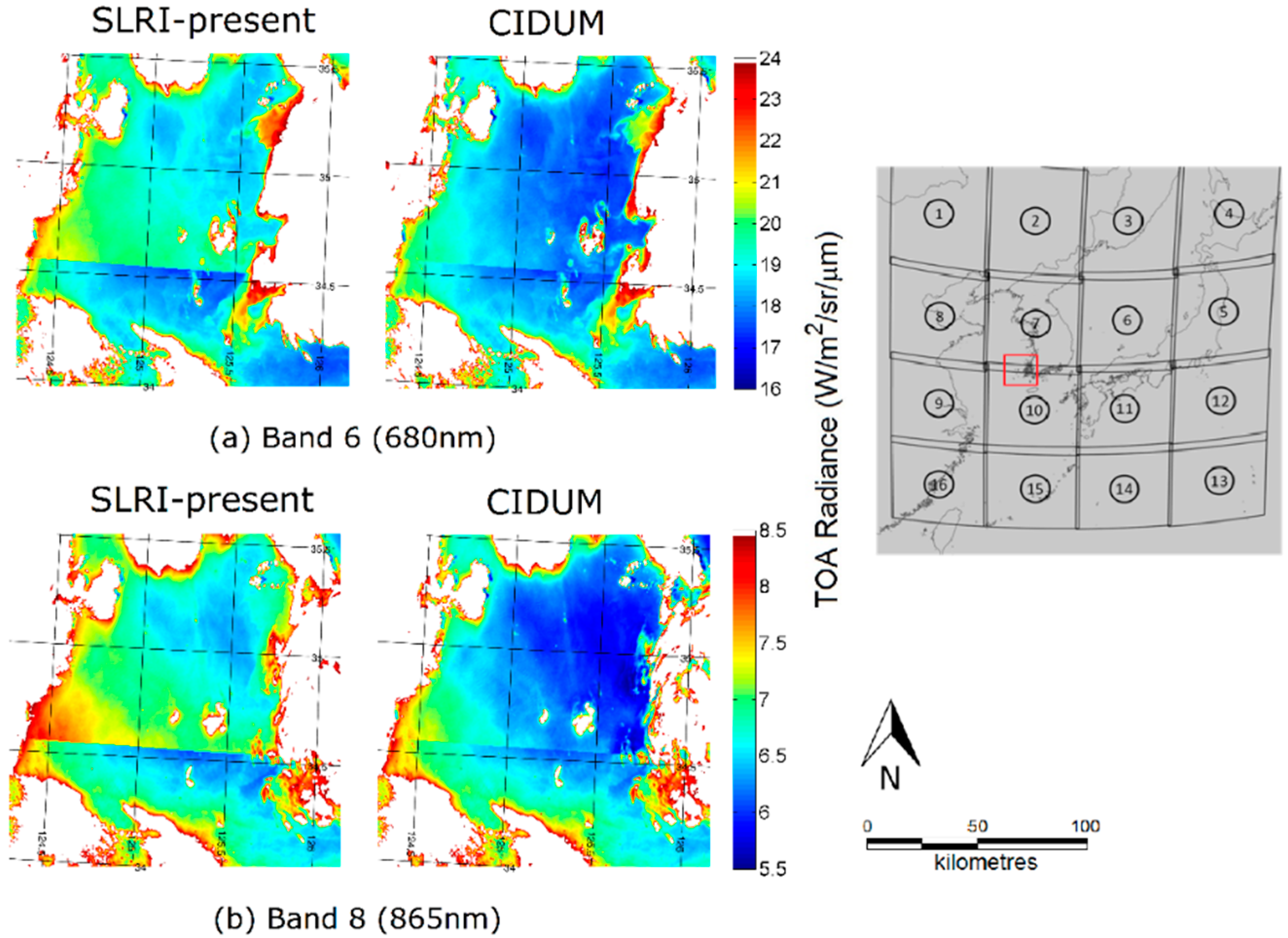
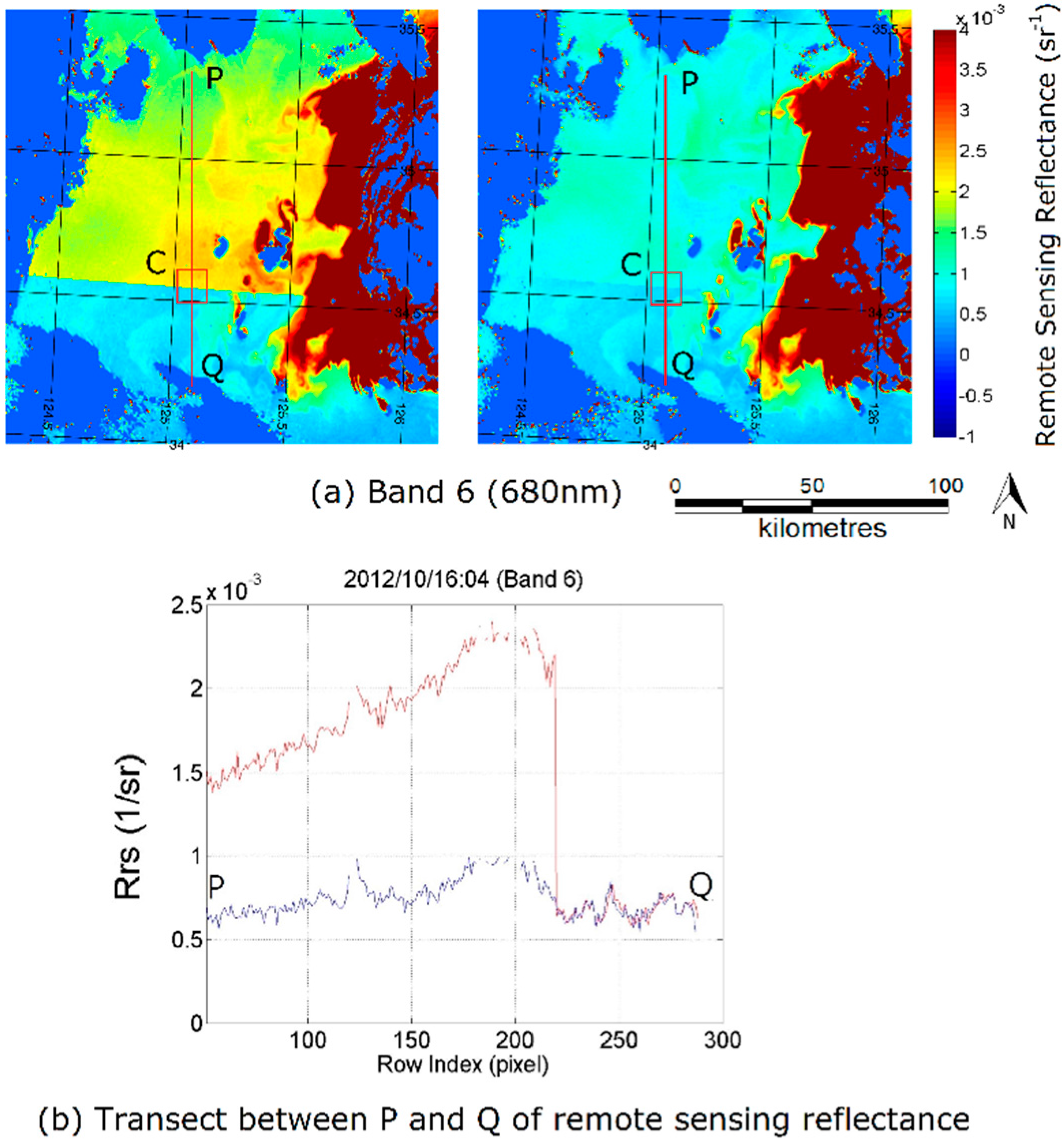


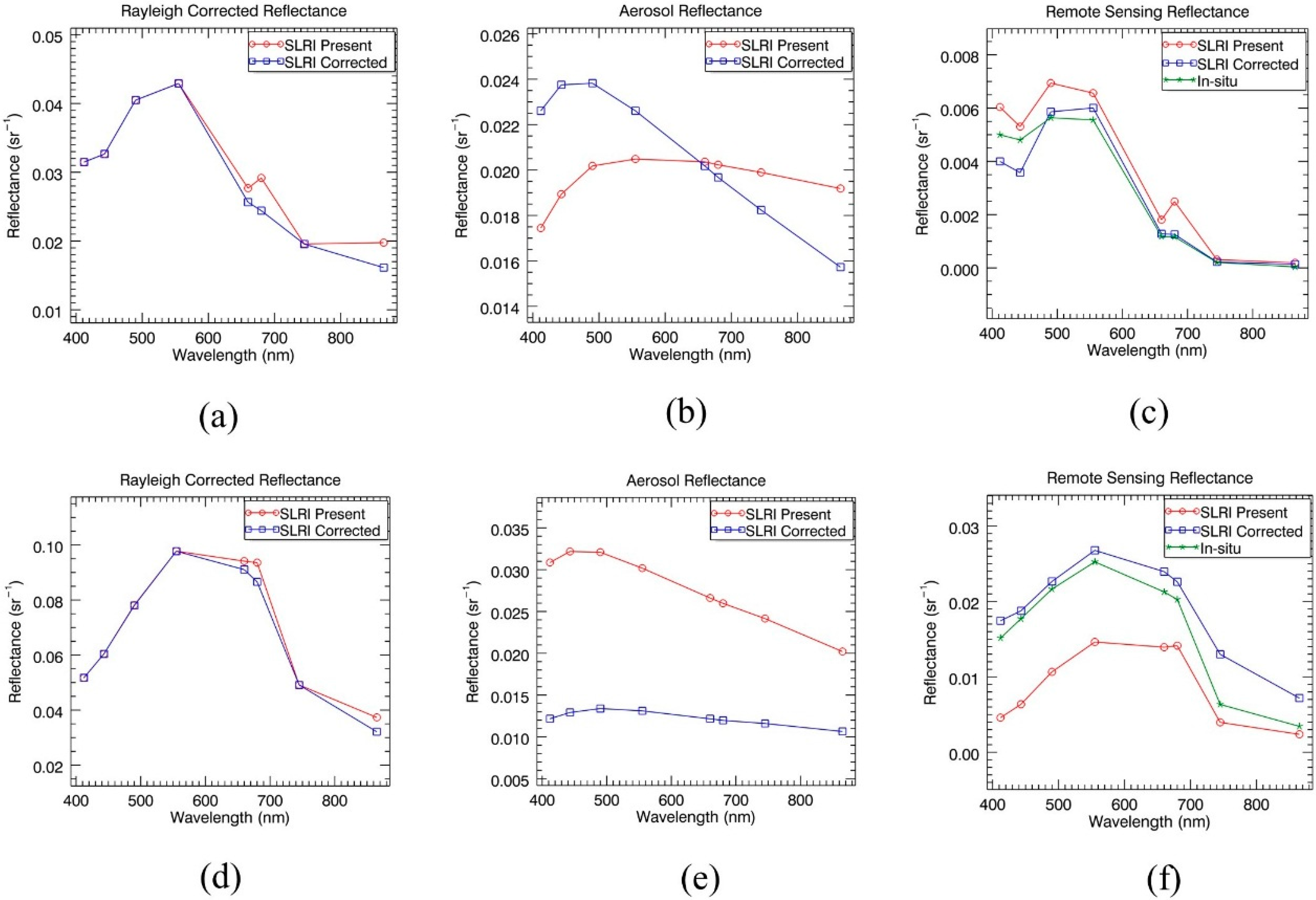

| ID | Year | Month | Day | Latitude | Longitude | Hour | Minute |
|---|---|---|---|---|---|---|---|
| 1 | 2012 | 07 | 31 | 35.5179 | 126.3264 | 02 | 04 |
| 2 | 35.5178 | 126.2855 | 02 | 23 | |||
| 3 | 35.6653 | 126.1580 | 05 | 10 | |||
| 4 | 2012 | 10 | 16 | 34.9686 | 126.0695 | 00 | 10 |
| 5 | 34.9671 | 126.0255 | 00 | 28 | |||
| 6 | 34.9656 | 125.9816 | 00 | 47 | |||
| 7 | 34.9642 | 125.9377 | 01 | 04 | |||
| 8 | 34.9626 | 125.8938 | 01 | 24 | |||
| 9 | 34.9611 | 125.8498 | 01 | 40 | |||
| 10 | 34.9596 | 125.8059 | 02 | 02 | |||
| 11 | 34.9564 | 125.7180 | 02 | 40 | |||
| 12 | 34.9533 | 125.6302 | 03 | 02 | |||
| 13 | 35.0219 | 125.5384 | 04 | 27 | |||
| 14 | 35.0251 | 125.6263 | 04 | 54 | |||
| 15 | 35.0283 | 125.7143 | 05 | 21 | |||
| 16 | 35.0315 | 125.8022 | 05 | 48 | |||
| 17 | 2013 | 10 | 23 | 35.1479 | 125.8511 | 00 | 20 |
| 18 | 35.1497 | 125.8528 | 01 | 25 | |||
| 19 | 35.1826 | 125.8072 | 01 | 58 | |||
| 20 | 35.1465 | 125.8483 | 02 | 27 | |||
| 21 | 35.1830 | 125.8476 | 02 | 52 | |||
| 22 | 35.1477 | 125.8503 | 03 | 22 | |||
| 23 | 35.1442 | 125.8495 | 04 | 27 | |||
| 24 | 35.1811 | 125.8887 | 04 | 52 | |||
| 25 | 35.1425 | 125.8474 | 06 | 23 | |||
| 26 | 35.1061 | 125.8036 | 06 | 53 |
| Correlation | APD () | RPD () | ||||
|---|---|---|---|---|---|---|
| Before | After | Before | After | Before | After | |
| Band 1 | 0.55 | 0.74 | 40.4 | 29.7 | −1.4 | 3.1 |
| Band 2 | 0.79 | 0.87 | 30.0 | 22.9 | −13.4 | −13.8 |
| Band 3 | 0.90 | 0.92 | 21.3 | 14.2 | −7.7 | −4.9 |
| Band 4 | 0.94 | 0.95 | 16.1 | 11.1 | −7.1 | −1.2 |
| Band 5 | 0.96 | 0.97 | 37.3 | 27.6 | −22.3 | −19.1 |
| Band 6 | 0.96 | 0.96 | 35.4 | 24.4 | −3.6 | −12.8 |
© 2016 by the authors; licensee MDPI, Basel, Switzerland. This article is an open access article distributed under the terms and conditions of the Creative Commons Attribution (CC-BY) license (http://creativecommons.org/licenses/by/4.0/).
Share and Cite
Kim, W.; Moon, J.-E.; Ahn, J.-H.; Park, Y.-J. Evaluation of Stray Light Correction for GOCI Remote Sensing Reflectance Using in Situ Measurements. Remote Sens. 2016, 8, 378. https://doi.org/10.3390/rs8050378
Kim W, Moon J-E, Ahn J-H, Park Y-J. Evaluation of Stray Light Correction for GOCI Remote Sensing Reflectance Using in Situ Measurements. Remote Sensing. 2016; 8(5):378. https://doi.org/10.3390/rs8050378
Chicago/Turabian StyleKim, Wonkook, Jeong-Eon Moon, Jae-Hyun Ahn, and Young-Je Park. 2016. "Evaluation of Stray Light Correction for GOCI Remote Sensing Reflectance Using in Situ Measurements" Remote Sensing 8, no. 5: 378. https://doi.org/10.3390/rs8050378





